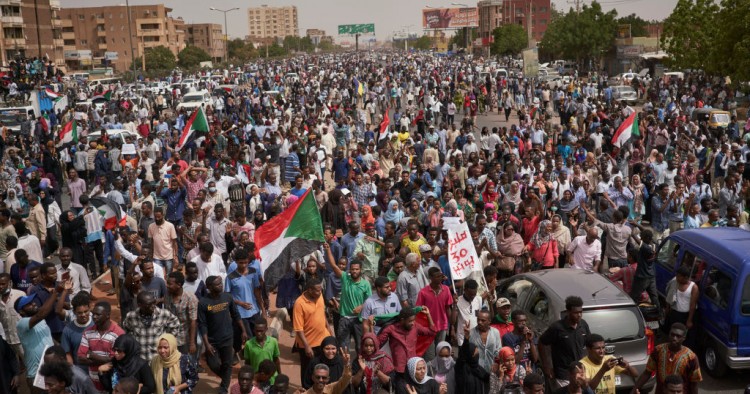The COVID-19 pandemic has delayed elections and brought about a surge in disinformation and rising authoritarianism worldwide. Popular protest movements are seeking ways to adapt to this new reality, and their survival is perhaps more important than ever in ensuring governments take a citizen-centered approach to the management of this crisis.
What lessons have some of the key protest movements of the past year taught us? Democracy and governance experts from the International Republican Institute (IRI) share their takeaways from three key protest movements: Sudan, Hong Kong, and Venezuela.
Sudan
Last April, 30 years of authoritarianism came to an end when protests erupted throughout the country. After toppling the regime of Omar al-Bashir, Sudan implemented a 33-month transitional government, with power shared by civilians and military. However, protesters — led primarily by women and youth — remain mobilized in the event the transitional government fails to meet their demands.
Whether or not women and youth will be allowed to retain a central role in moving Sudan toward a more democratic future remains to be seen. Thus far, political parties have not integrated these marginalized groups into their governing structures, and both groups remain skeptical of political parties. Although the civilian government has appointed women to a few top-tier positions, they remain woefully underrepresented elsewhere in government. Although 40 percent of the transitional government’s National Assembly is required to consist of women, the Assembly has yet to be seated and long-standing cultural norms blocking the political inclusion of women and youth remain strong. Notably, there are no requirements for youth representation within the new government.
Hong Kong
The 2019 Hong Kong protest movement has built upon the lessons of the 2014 demonstrations. The government not only failed to address the movement’s 2014 demand of universal suffrage, but continued to undermine Hong Kong’s democracy with actions such as blocking elected legislators from positions and eroding media freedoms.
Though officially leaderless, the resurgent protest movement that kicked off in 2019 has united around five demands and is run by numerous organizers, spokespeople, and informal leaders. The movement’s sustainability is tied to its high level of legitimacy and support from the general population. Observers believe continued police violence and overreaction has only bolstered the movement’s legitimacy by highlighting the government’s wrongdoing.
The pro-democracy camp’s resounding victory in the November 2019 elections provided clear evidence of the support the general public has for the protesters — there is no silent majority against them. However, a stalemate between the protest movement and the Beijing-controlled government remains in place. Even if the government were willing to negotiate, the lack of a clear leader of the movement would make this difficult. In order to support Hong Kong’s fight for freedom, it is imperative that the international community devote increased resources to working with university student groups, political parties, legal organizations, civil society organizations, and others on the ground.
Venezuela
While not a protest movement per se, Venezuela’s coalition of democratic forces has achieved remarkable success throughout its history. For many years, Venezuelans failed to forge an alliance between the main opposition leaders fighting against the Chavez and Maduro regimes. More recently, these democratic parties built a coalition of forces called the Unity Table and secured victory in the 2015 parliamentary elections — winning two-thirds of the seats and appointing an interim president recognized by many countries in the Western Hemisphere. Here’s how they made that happen:
- The opposition parties appointed a trusted coordinator to oversee the creation of a dialogue methodology. A group of technicians and one politician — who did not represent any one political party but earned the respect of several — facilitated discussions between relevant stakeholders on the mechanism by which they would determine an electoral strategy. They did not begin with political, programmatic, or ideological agreements or even a shared vision, but deployed a simple methodology to discuss these topics. After a year of planning next steps, a platform of parties was created. This technique was especially effective because the politician overseeing the process was not interested in becoming president.
- Once the platform was built, the Unity Table focused on electing candidates to the National Assembly. Two years later, they united around a single strategy to avoid infighting. They agreed that the political party with the most followers in each geographic area elected the candidates; in places where there was a dispute, primaries would take place.
- The Unity Table built a united strategy for elections. It divided tasks and geographic areas between the parties. With each candidate speaking to different groups, the Table created a method of operation without compromising the individual agendas and ideologies of the parties. As a member of the movement put it, “They learned to think differently, but together.”
Although the Unity Table no longer exists, its decision-making platform remains in place and has enabled Venezuela’s democratic forces to unite around a single agenda, platform, strategy, and a shared vision.
Gregory Kearns is IRI's Regional Director for Africa. Adam King is IRI's Senior Program Manager for Asia. Horacio Salas is IRI's Program Director for Latin America and the Caribbean. The views expressed in this piece are their own.
Photo by David Degner/Getty Images
The Middle East Institute (MEI) is an independent, non-partisan, non-for-profit, educational organization. It does not engage in advocacy and its scholars’ opinions are their own. MEI welcomes financial donations, but retains sole editorial control over its work and its publications reflect only the authors’ views. For a listing of MEI donors, please click here.













